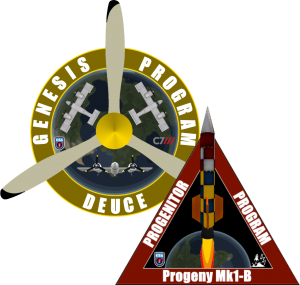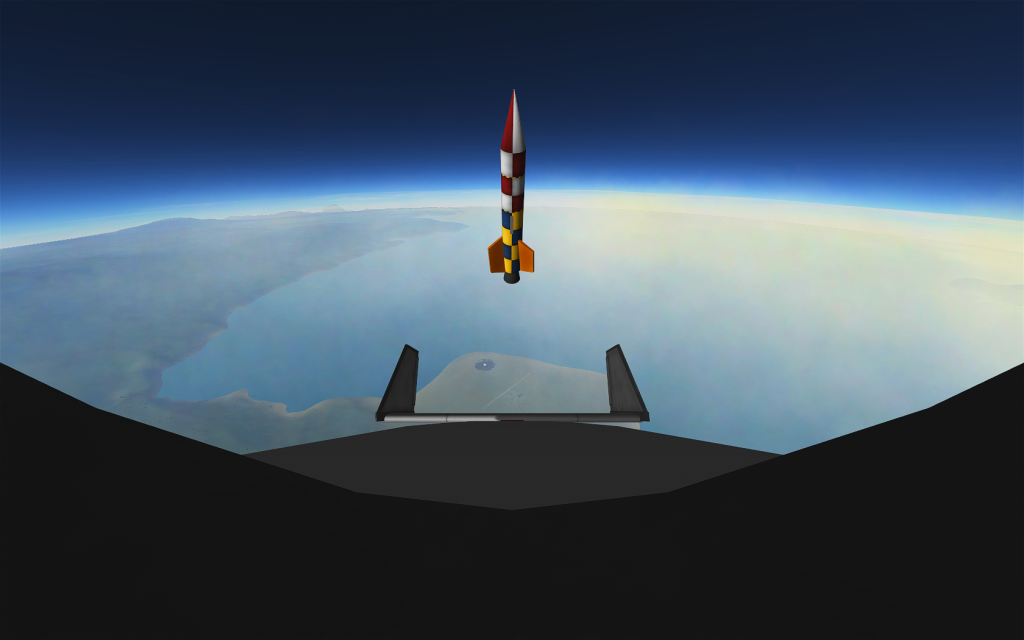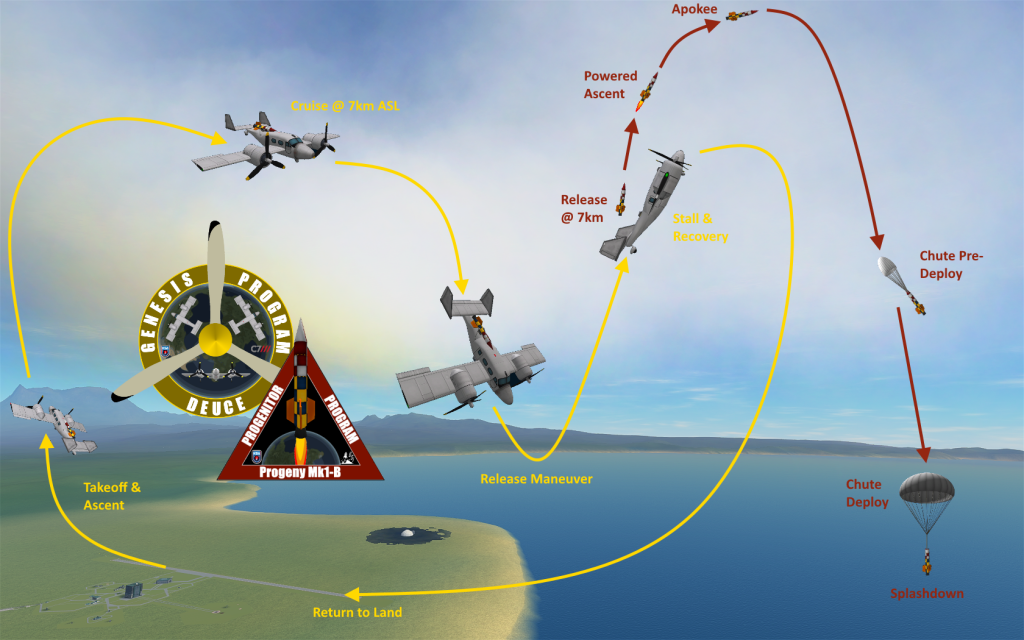 A little over a year and a half after the idea was first put forward by Captain Jebediah and after months of preparation, at the end of last month we finally were able to launch a rocket off an aircraft while in flight. It was a great accomplishment and the main goal was achieved: to prove that such an operation can be carried out without excessive danger to the crew of the aircraft (in this case Flight Officers Tedman and Aldeny) or the rocket itself in being able to complete its own mission. We’ll review the process leading up to the launch before covering the launch flight itself.
A little over a year and a half after the idea was first put forward by Captain Jebediah and after months of preparation, at the end of last month we finally were able to launch a rocket off an aircraft while in flight. It was a great accomplishment and the main goal was achieved: to prove that such an operation can be carried out without excessive danger to the crew of the aircraft (in this case Flight Officers Tedman and Aldeny) or the rocket itself in being able to complete its own mission. We’ll review the process leading up to the launch before covering the launch flight itself.
Launch Preparation
Once it was confirmed that the rocket could be properly placed atop the aircraft, the first mission began with the simple goal of making sure the Deuce could takeoff and fly normally with the extra weight on the tail and its aerodynamic effects. Both concerns turned out to be minimal, at best – the piggyback was giving the aircraft no trouble whatsoever and it was able to reach an altitude of 7km ASL before climbing became too difficult to continue. That determined the release altitude, and Flight had no problems with going for a release of the rocket on this first test mission given how well-behaved the aircraft was. The release went exactly as planned – the decoupler placed forward of the rocket’s center of mass kicked it back and upright from a flight level position before it fell behind the aircraft, nowhere near striking the tail, which was another concern.
Despite the clean release of the first flight, we wanted to get the rocket closer to vertical for ignition, this time to ensure it not only cleared the rear of the aircraft if ignition failed on the actual attempt but that it also cleared the front of the aircraft when it flew off. Ideally we were aiming for an 80° ascent angle similar to how this rocket was shot from the ground for a more well-understood flight profile. Because the aircraft was so near to its service ceiling at 7km ASL, pulling up into a climb straight from level flight would have likely resulted in a stall too soon. So the pilots performed a steep dive down to 6.5km followed by a power climb at full throttle back up to 7km at a high pitch angle for the rocket release. It took two attempts to reach a good climb but the eventual release went off without a hitch.
The third flight aimed to climb at a steeper angle, since the last flight came up a bit short on reaching the target pitch for the rocket. The goal this time around was to shoot a bit higher for 85° to also see whether the aircraft could manage such a steep climb – reaching as much as 50-55° pitch itself. The Deuce performed the maneuver with no problem and hit its target pitch angle but the rocket only ended up kicking up to 74°, which was slightly less than the previous flight. It was determined that the larger pitch angle gave less airflow to the rocket after release, lessening the lift at the nose – so it just wanted to kind of “hang out” in its already mostly-upright position rather than rotate further upwards.
Rather than change the mounting of the rocket for a bigger kick from the front, which could have been tricky to keep it snug to the tail, the excellent performance of the aircraft meant it could just climb even steeper on the next attempt. This would still bring it closer to a dangerous stall however and as such we needed to make sure both crew members had hands and focus on the controls for a safe recovery. The aircraft flight computer was thus programmed to handle the release if the proper conditions were met, which had been done manually by the co-pilot on previous flights. The aircraft flew the release maneuver with a pitch of 65° and the rocket was automatically let go, nosing up to 81°, before falling over and down well behind the aircraft. This met both of the main launch criteria.
The final preparation flight was designed to emulate the previous one to ensure that the release of the rocket was able to be repeated within launch criteria. It also was meant to test the code on the rocket flight computer that would detect the release and ignite the booster engine once it reached its target pitch of 80°. The first attempt at the mission was foiled by the Monolith EM field coming online, but the follow-up attempt once KSA operations resumed was a complete success, including a drop over the water this time to allow a drill for the recovery team. This finally made everyone as confident as possible that the mission could be carried out safely and the GO for ignition on the next flight was given.
Launch Execution
The launch was conducted just like the previous rehearsal mission, except this time when it was released the booster was armed and able to be ignited by the flight computer. Because the probe unit on this older rocket is not as capable as the newer Mk5+ models, it could not handle both the release conditions as well as the ignition conditions while also recording flight telemetry, so the aircraft flight computer still managed the release of the rocket, which then told itself to ignite when the proper conditions were met.
The first release attempt produced viable launch conditions and the booster successfully ignited, sending the rocket screaming upwards with an initial TWR of 17. It went from 121m/s to 823m/s in just 6 seconds after boosting for 5, creating 20Gs of force. Apokee was 16,398.919m, reached 28 seconds into the flight. The pilots of the Deuce reported they did get buffeted a bit by the rocket exhaust, but still had no problem recovering from the stall that came shortly after release. They circled down and landed without issue as the rocket was being recovered from the water. You can review the entire rocket flight on our Ops Tracker.
Everyone is happy the overall mission was a well-planned and well-executed success! You can read more detailed reports of each individual mission if you wish.
Future Plans
There is no direct analysis to be made between this Mk1-B flight and the ones we launched from the ground, although if you want to you can review the telemetry data here. Again, the main purpose of this exercise was to determine if such a thing was even feasible. Now that we know it is, Genesis and Progenitor will both be keeping a close eye on future mission requirements, launch vehicle and carry vehicle capabilities. If a sweet spot is found that can take advantage of the increased performance from a higher launch altitude, taking into consideration the cost of outfitting and flying an aircraft up there, we may put this concept to use again someday.
As for right now, the Deuce is not large enough to strap on a Progeny Mk6 or anything heavier, so we will continue to launch from the ground. The Dhumla is also not a feasible carry vehicle – it has no room below, a single vertical tail that would be a strike hazard or see damage from rocket exhaust if launch from the top, and the propellers leave no place to mount a rocket on the wings. Designing an aircraft specifically for carrying a rocket would not be cost-effective until we have a stronger commercial industry behind us for sending things up into space.
Everyone agrees this was the coolest non-space mission we’ve yet done however, so we hope one day we can do it again and go to space as well!









